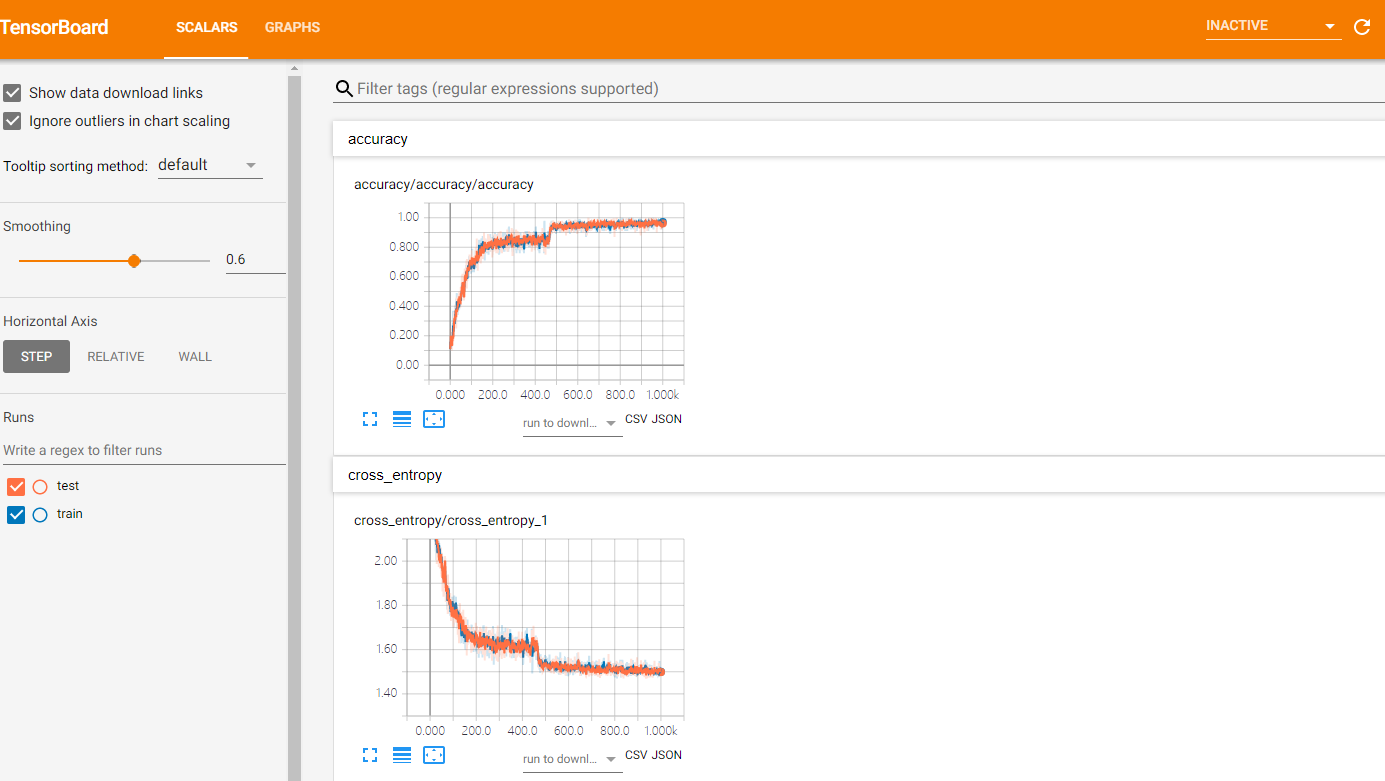TensorFlow卷积神经网络实现手写数字识别以及可视化
边学习边笔记
https://www.cnblogs.com/felixwang2/p/9190602.html
# https://www.cnblogs.com/felixwang2/p/9190602.html
# TensorFlow(十):卷积神经网络实现手写数字识别以及可视化 import tensorflow as tf
from tensorflow.examples.tutorials.mnist import input_data mnist = input_data.read_data_sets('MNIST_data', one_hot=True) # 每个批次的大小
batch_size = 100
# 计算一共有多少个批次
n_batch = mnist.train.num_examples // batch_size # 参数概要
def variable_summaries(var):
with tf.name_scope('summaries'):
mean = tf.reduce_mean(var)
tf.summary.scalar('mean', mean) # 平均值
with tf.name_scope('stddev'):
stddev = tf.sqrt(tf.reduce_mean(tf.square(var - mean)))
tf.summary.scalar('stddev', stddev) # 标准差
tf.summary.scalar('max', tf.reduce_max(var)) # 最大值
tf.summary.scalar('min', tf.reduce_min(var)) # 最小值
tf.summary.histogram('histogram', var) # 直方图 # 初始化权值
def weight_variable(shape, name):
initial = tf.truncated_normal(shape, stddev=0.1) # 生成一个截断的正态分布
return tf.Variable(initial, name=name) # 初始化偏置
def bias_variable(shape, name):
initial = tf.constant(0.1, shape=shape)
return tf.Variable(initial, name=name) # 卷积层
def conv2d(x, W):
# x input tensor of shape `[batch, in_height, in_width, in_channels]`
# W filter / kernel tensor of shape [filter_height, filter_width, in_channels, out_channels]
# `strides[0] = strides[3] = 1`. strides[1]代表x方向的步长,strides[2]代表y方向的步长
# padding: A `string` from: `"SAME", "VALID"`
return tf.nn.conv2d(x, W, strides=[1, 1, 1, 1], padding='SAME') # 池化层
def max_pool_2x2(x):
# ksize [1,x,y,1]
return tf.nn.max_pool(x, ksize=[1, 2, 2, 1], strides=[1, 2, 2, 1], padding='SAME') # 命名空间
with tf.name_scope('input'):
# 定义两个placeholder
x = tf.placeholder(tf.float32, [None, 784], name='x-input')
y = tf.placeholder(tf.float32, [None, 10], name='y-input')
with tf.name_scope('x_image'):
# 改变x的格式转为4D的向量[batch, in_height, in_width, in_channels]`
x_image = tf.reshape(x, [-1, 28, 28, 1], name='x_image') with tf.name_scope('Conv1'):
# 初始化第一个卷积层的权值和偏置
with tf.name_scope('W_conv1'):
W_conv1 = weight_variable([5, 5, 1, 32], name='W_conv1') # 5*5的采样窗口,32个卷积核从1个平面抽取特征
with tf.name_scope('b_conv1'):
b_conv1 = bias_variable([32], name='b_conv1') # 每一个卷积核一个偏置值 # 把x_image和权值向量进行卷积,再加上偏置值,然后应用于relu激活函数
with tf.name_scope('conv2d_1'):
conv2d_1 = conv2d(x_image, W_conv1) + b_conv1
with tf.name_scope('relu'):
h_conv1 = tf.nn.relu(conv2d_1)
with tf.name_scope('h_pool1'):
h_pool1 = max_pool_2x2(h_conv1) # 进行max-pooling with tf.name_scope('Conv2'):
# 初始化第二个卷积层的权值和偏置
with tf.name_scope('W_conv2'):
W_conv2 = weight_variable([5, 5, 32, 64], name='W_conv2') # 5*5的采样窗口,64个卷积核从32个平面抽取特征
with tf.name_scope('b_conv2'):
b_conv2 = bias_variable([64], name='b_conv2') # 每一个卷积核一个偏置值 # 把h_pool1和权值向量进行卷积,再加上偏置值,然后应用于relu激活函数
with tf.name_scope('conv2d_2'):
conv2d_2 = conv2d(h_pool1, W_conv2) + b_conv2
with tf.name_scope('relu'):
h_conv2 = tf.nn.relu(conv2d_2)
with tf.name_scope('h_pool2'):
h_pool2 = max_pool_2x2(h_conv2) # 进行max-pooling # 28*28的图片第一次卷积后还是28*28,第一次池化后变为14*14
# 第二次卷积后为14*14,第二次池化后变为了7*7
# 经过上面操作后得到64张7*7的平面 with tf.name_scope('fc1'):
# 初始化第一个全连接层的权值
with tf.name_scope('W_fc1'):
W_fc1 = weight_variable([7 * 7 * 64, 1024], name='W_fc1') # 上一场有7*7*64个神经元,全连接层有1024个神经元
with tf.name_scope('b_fc1'):
b_fc1 = bias_variable([1024], name='b_fc1') # 1024个节点 # 把池化层2的输出扁平化为1维
with tf.name_scope('h_pool2_flat'):
h_pool2_flat = tf.reshape(h_pool2, [-1, 7 * 7 * 64], name='h_pool2_flat')
# 求第一个全连接层的输出
with tf.name_scope('wx_plus_b1'):
wx_plus_b1 = tf.matmul(h_pool2_flat, W_fc1) + b_fc1
with tf.name_scope('relu'):
h_fc1 = tf.nn.relu(wx_plus_b1) # keep_prob用来表示神经元的输出概率
with tf.name_scope('keep_prob'):
keep_prob = tf.placeholder(tf.float32, name='keep_prob')
with tf.name_scope('h_fc1_drop'):
h_fc1_drop = tf.nn.dropout(h_fc1, keep_prob, name='h_fc1_drop') with tf.name_scope('fc2'):
# 初始化第二个全连接层
with tf.name_scope('W_fc2'):
W_fc2 = weight_variable([1024, 10], name='W_fc2')
with tf.name_scope('b_fc2'):
b_fc2 = bias_variable([10], name='b_fc2')
with tf.name_scope('wx_plus_b2'):
wx_plus_b2 = tf.matmul(h_fc1_drop, W_fc2) + b_fc2
with tf.name_scope('softmax'):
# 计算输出
prediction = tf.nn.softmax(wx_plus_b2) # 交叉熵代价函数
with tf.name_scope('cross_entropy'):
cross_entropy = tf.reduce_mean(tf.nn.softmax_cross_entropy_with_logits_v2(labels=y, logits=prediction),
name='cross_entropy')
tf.summary.scalar('cross_entropy', cross_entropy) # 使用AdamOptimizer进行优化
with tf.name_scope('train'):
train_step = tf.train.AdamOptimizer(1e-4).minimize(cross_entropy) # 求准确率
with tf.name_scope('accuracy'):
with tf.name_scope('correct_prediction'):
# 结果存放在一个布尔列表中
correct_prediction = tf.equal(tf.argmax(prediction, 1), tf.argmax(y, 1)) # argmax返回一维张量中最大的值所在的位置
with tf.name_scope('accuracy'):
# 求准确率
accuracy = tf.reduce_mean(tf.cast(correct_prediction, tf.float32))
tf.summary.scalar('accuracy', accuracy) # 合并所有的summary
merged = tf.summary.merge_all() gpu_options = tf.GPUOptions(allow_growth=True)
with tf.Session(config=tf.ConfigProto(gpu_options=gpu_options)) as sess:
sess.run(tf.global_variables_initializer())
train_writer = tf.summary.FileWriter('logs/train', sess.graph)
test_writer = tf.summary.FileWriter('logs/test', sess.graph)
for i in range(1001):
# 训练模型
batch_xs, batch_ys = mnist.train.next_batch(batch_size)
sess.run(train_step, feed_dict={x: batch_xs, y: batch_ys, keep_prob: 0.5})
# 记录训练集计算的参数
summary = sess.run(merged, feed_dict={x: batch_xs, y: batch_ys, keep_prob: 1.0})
train_writer.add_summary(summary, i)
# 记录测试集计算的参数
batch_xs, batch_ys = mnist.test.next_batch(batch_size)
summary = sess.run(merged, feed_dict={x: batch_xs, y: batch_ys, keep_prob: 1.0})
test_writer.add_summary(summary, i) if i % 100 == 0:
test_acc = sess.run(accuracy, feed_dict={x: mnist.test.images, y: mnist.test.labels, keep_prob: 1.0})
train_acc = sess.run(accuracy, feed_dict={x: mnist.train.images[:10000], y: mnist.train.labels[:10000],
keep_prob: 1.0})
print("Iter " + str(i) + ", Testing Accuracy= " + str(test_acc) + ", Training Accuracy= " + str(train_acc))
应该是随便在某个路径下,右键,打开powershell窗口,输入如下命令:
tensorboard --logdir=F:\document\PyCharm\temp\logs
之后会在窗口输出:
TensorBoard 1.10. at http://KOTIN:6006 (Press CTRL+C to quit)
然后在浏览器输入
http://KOTIN:6006
就可以进入tensorboard查看参数的可视化信息:


TensorFlow卷积神经网络实现手写数字识别以及可视化的更多相关文章
- TensorFlow(十):卷积神经网络实现手写数字识别以及可视化
上代码: import tensorflow as tf from tensorflow.examples.tutorials.mnist import input_data mnist = inpu ...
- 卷积神经网络CNN 手写数字识别
1. 知识点准备 在了解 CNN 网络神经之前有两个概念要理解,第一是二维图像上卷积的概念,第二是 pooling 的概念. a. 卷积 关于卷积的概念和细节可以参考这里,卷积运算有两个非常重要特性, ...
- 基于卷积神经网络的手写数字识别分类(Tensorflow)
import numpy as np import tensorflow as tf from tensorflow.examples.tutorials.mnist import input_dat ...
- 莫烦pytorch学习笔记(八)——卷积神经网络(手写数字识别实现)
莫烦视频网址 这个代码实现了预测和可视化 import os # third-party library import torch import torch.nn as nn import torch ...
- BP神经网络的手写数字识别
BP神经网络的手写数字识别 ANN 人工神经网络算法在实践中往往给人难以琢磨的印象,有句老话叫“出来混总是要还的”,大概是由于具有很强的非线性模拟和处理能力,因此作为代价上帝让它“黑盒”化了.作为一种 ...
- 利用c++编写bp神经网络实现手写数字识别详解
利用c++编写bp神经网络实现手写数字识别 写在前面 从大一入学开始,本菜菜就一直想学习一下神经网络算法,但由于时间和资源所限,一直未展开比较透彻的学习.大二下人工智能课的修习,给了我一个学习的契机. ...
- 第三节,TensorFlow 使用CNN实现手写数字识别(卷积函数tf.nn.convd介绍)
上一节,我们已经讲解了使用全连接网络实现手写数字识别,其正确率大概能达到98%,这一节我们使用卷积神经网络来实现手写数字识别, 其准确率可以超过99%,程序主要包括以下几块内容 [1]: 导入数据,即 ...
- 第二节,TensorFlow 使用前馈神经网络实现手写数字识别
一 感知器 感知器学习笔记:https://blog.csdn.net/liyuanbhu/article/details/51622695 感知器(Perceptron)是二分类的线性分类模型,其输 ...
- TensorFlow.NET机器学习入门【5】采用神经网络实现手写数字识别(MNIST)
从这篇文章开始,终于要干点正儿八经的工作了,前面都是准备工作.这次我们要解决机器学习的经典问题,MNIST手写数字识别. 首先介绍一下数据集.请首先解压:TF_Net\Asset\mnist_png. ...
随机推荐
- java简单学生成绩管理系统
题目要求: 一. 数据结构要求:(5 分) 1.定义 ScoreInformation 类,其中包括七个私有变量(stunumber, name, mathematicsscore, englishi ...
- 最近手机价格全线暴跌真的只是因为5G要来了吗?
等等党,是一群数量颇大的消费群体.他们的消费习性是绝不买刚上市的新品,而是一直等.等到他们认为产品的价格已经跌无可跌,或者性价比十足的时候再出手.不得不说,与早买早享受的尝鲜消费群体相比,等等党代表了 ...
- MyEclipse 安装及激活教程
一.下载安装MyEclipse 在进行下面的步骤之前,先安装好MyEclipse (10.0.2015版本或更高版本)和JDK,安装完成后暂时不要运行MyEclipse. 二.运行MyEclipse激 ...
- 一则关于控制文件全部丢失后如何重新编目RMAN元数据的简单实验
主题:一则简单的RMAN元数据编目实验,来自于博客园AskScuti. 场景:RMAN备份完整情况下,未使用Catalog目录库.删除了所有的控制文件,在手工重建后,导致记录在控制文件中的RMAN备份 ...
- Chrome浏览器所有页面崩溃
问题描述 Chrome浏览器所有页面崩溃,包括设置页面,"喔唷,崩溃啦!" 显示错误码:STATUS_INVALID_IMAGE_HASH Chrome所有插件报错,右下角一串弹框 ...
- js加密(二)文书获取
时间原因直接上代码,有空再解释. js代码: //var tm=new Array(1) //tm[0]=e; ////tm[1]="%u5e72%u82e5%u4f5c%u5de5%u88 ...
- bbs论坛注册功能(1)
分析项目需求创建表: STATICFILE_DIR = [ os.path.join(BASE_DIR,'static') #设置目录,bootstrip添加到目录中去,直接本地调用 ] # auth ...
- SQLServer使用链接服务器远程查询
--创建链接服务器 exec sp_addlinkedserver 'ITSV ', ' ', 'SQLOLEDB ', '远程服务器名或ip地址 ' exec sp_addlinkedsrvlogi ...
- access denied (2)
除了https://www.cnblogs.com/bneglect/p/11558593.html 这里提到的以外,今天再记录一个新的原因造成这种情况的解决方法.path_info 这个算是路由模 ...
- 线性回归-Fork
线性回归 主要内容包括: 线性回归的基本要素 线性回归模型从零开始的实现 线性回归模型使用pytorch的简洁实现 线性回归的基本要素 模型 为了简单起见,这里我们假设价格只取决于房屋状况的两个因 ...
